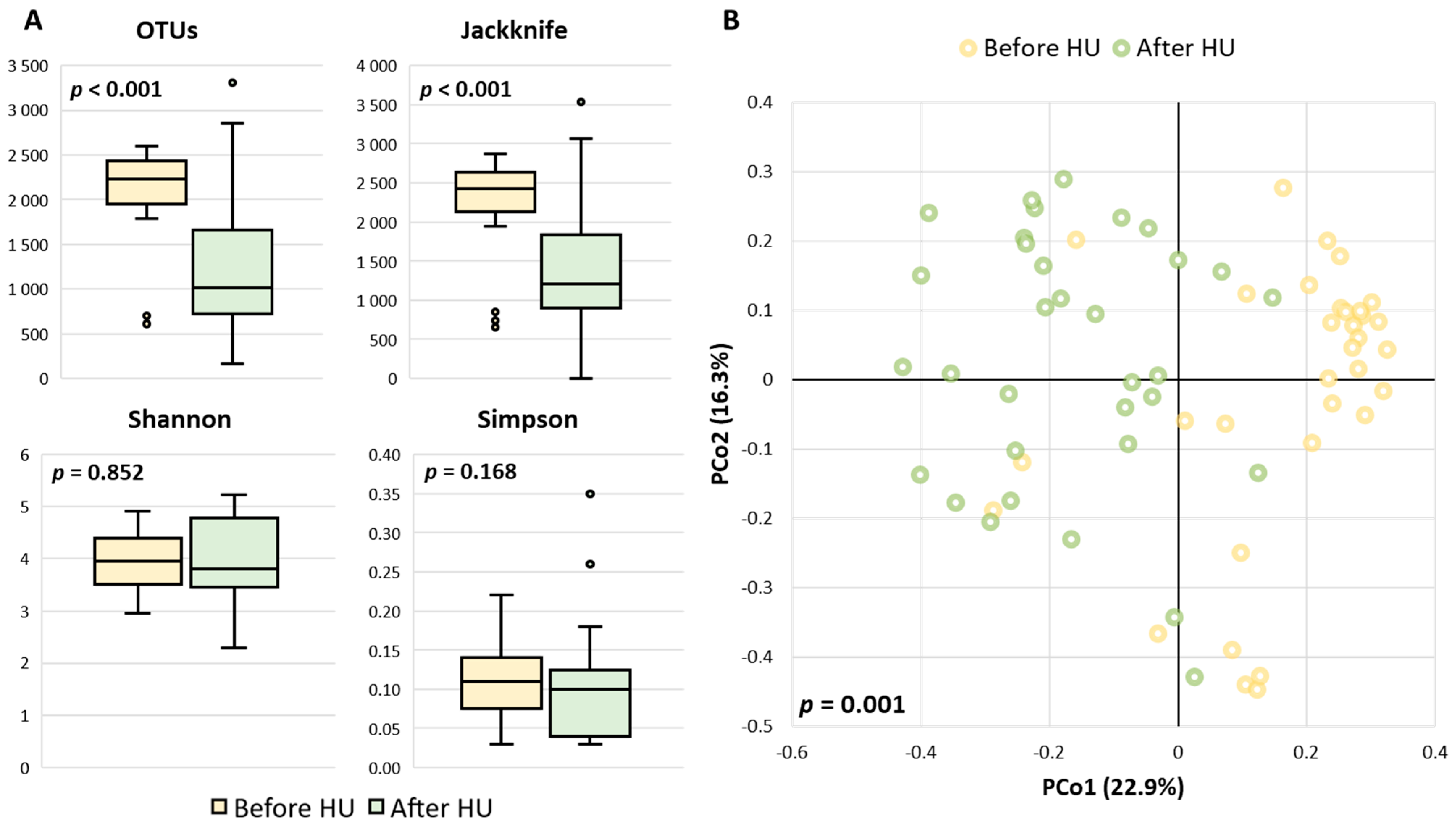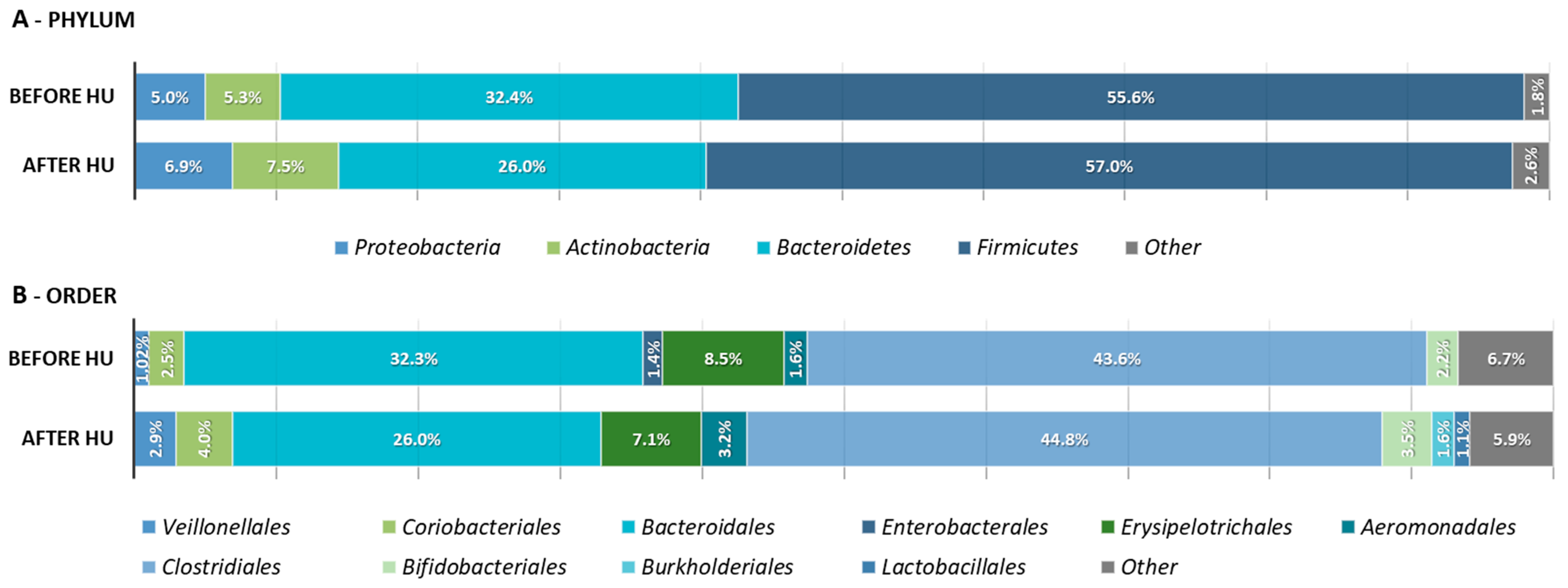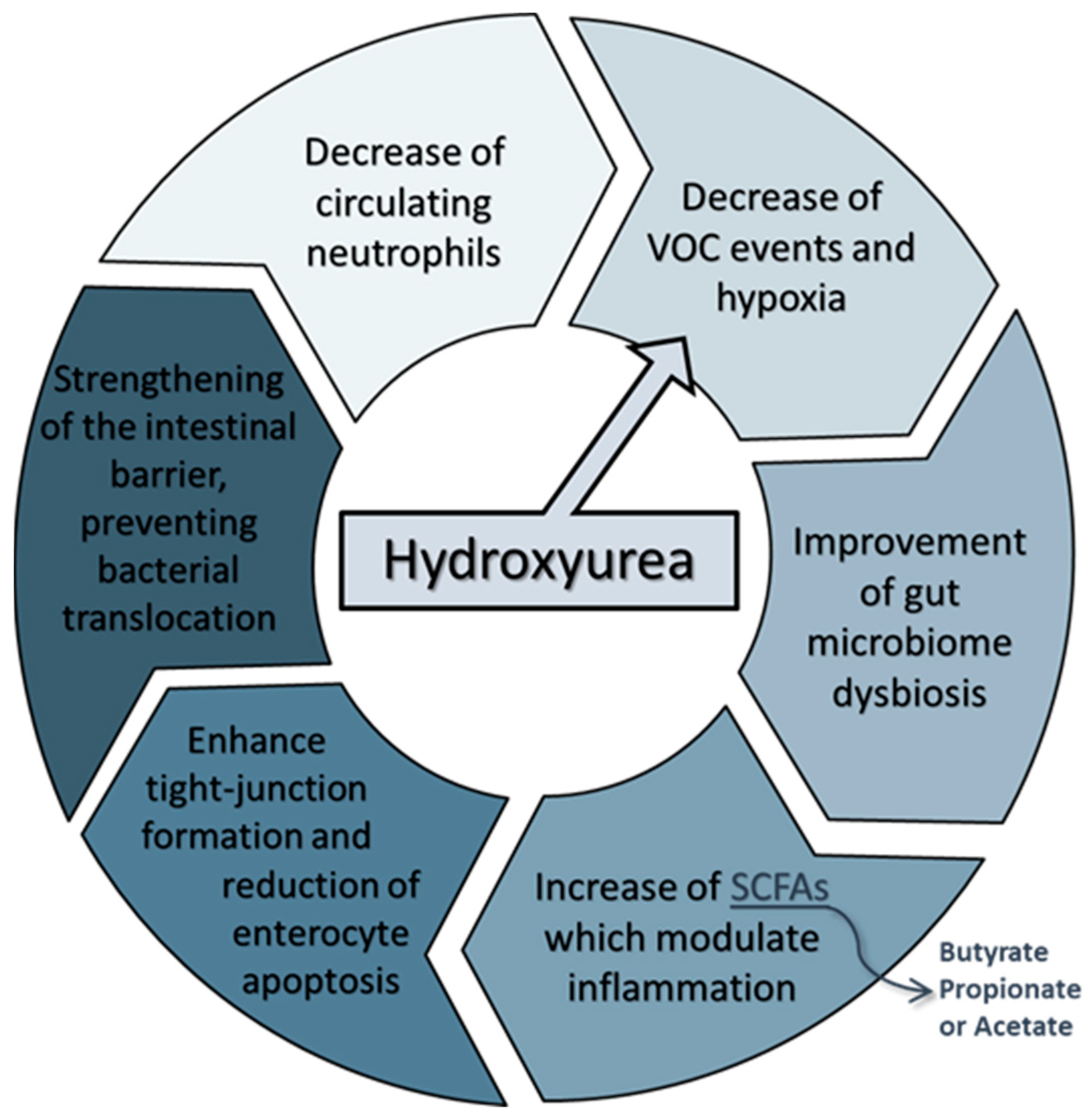How Hydroxyurea Alters the Gut Microbiome: A Longitudinal Study Involving Angolan Children with Sickle Cell Anemia
Abstract
:1. Introduction
2. Results
2.1. Overview of Clinical Characteristics
2.2. Metagenomic Data
2.3. Hydroxyurea Impact on Alpha and Beta Diversities
2.4. Hydroxyurea-Induced Differences in Gut Microbiome Composition
3. Discussion
4. Materials and Methods
4.1. Study Design and Ethical Considerations
4.2. Sample Collection and Clinical Analyses
4.3. DNA Extraction and 16S rRNA Sequencing
4.4. Quality-Control and Statistical Analysis
5. Conclusions
Author Contributions
Funding
Institutional Review Board Statement
Informed Consent Statement
Data Availability Statement
Acknowledgments
Conflicts of Interest
References
- Nazon, C.; Sabo, A.-N.; Becker, G.; Lessinger, J.-M.; Kemmel, V.; Paillard, C. Optimizing Hydroxyurea Treatment for Sickle Cell Disease Patients: The Pharmacokinetic Approach. J. Clin. Med. 2019, 8, 1701. [Google Scholar] [CrossRef] [PubMed]
- Kato, G.J.; Piel, F.B.; Reid, C.D.; Gaston, M.H.; Ohene-Frempong, K.; Krishnamurti, L.; Smith, W.R.; Panepinto, J.A.; Weatherall, D.J.; Costa, F.F.; et al. Sickle Cell Disease. Nat. Rev. Dis. Prim. 2018, 4, 18010. [Google Scholar] [CrossRef] [PubMed]
- Bello-Manga, H.; DeBaun, M.R.; Kassim, A.A. Epidemiology and treatment of relative anemia in children with sickle cell disease in sub-Saharan Africa. Expert Rev. Hematol. 2016, 9, 1031–1042. [Google Scholar] [CrossRef] [PubMed]
- Mulumba, L.L.; Wilson, L. Sickle cell disease among children in Africa: An integrative literature review and global recommendations. Int. J. Afr. Nurs. Sci. 2015, 3, 56–64. [Google Scholar] [CrossRef]
- Piel, F.B. The Present and Future Global Burden of the Inherited Disorders of Hemoglobin. Hematol. Clin. North Am. 2016, 30, 327–341. [Google Scholar] [CrossRef]
- Wastnedge, E.; Waters, D.; Patel, S.; Morrison, K.; Goh, M.Y.; Adeloye, D.; Rudan, I. The global burden of sickle cell disease in children under five years of age: A systematic review and meta-analysis. J. Glob. Health 2018, 8, 021103. [Google Scholar] [CrossRef]
- Meier, E.R.; Fasano, R.M.; Levett, P.R. A systematic review of the literature for severity predictors in children with sickle cell anemia. Blood Cells Mol. Dis. 2017, 65, 86–94. [Google Scholar] [CrossRef] [PubMed]
- Ma, Q.; Wyszynski, D.F.; Farrell, J.J.; Kutlar, A.; Farrer, L.; Baldwin, C.T.; Steinberg, M. Fetal hemoglobin in sickle cell anemia: Genetic determinants of response to hydroxyurea. Pharm. J. 2007, 7, 386–394. [Google Scholar] [CrossRef]
- Williams, T.N.; Thein, S.L. Sickle Cell Anemia and Its Phenotypes. Annu. Rev. Genom. Hum. Genet. 2018, 19, 113–147. [Google Scholar] [CrossRef] [PubMed]
- Thornburg, C.D.; Files, B.A.; Luo, Z.; Miller, S.T.; Kalpatthi, R.; Iyer, R.; Seaman, P.; Lebensburger, J.; Alvarez, O.; Thompson, B.; et al. Impact of hydroxyurea on clinical events in the BABY HUG trial. Blood 2012, 120, 4304–4310. [Google Scholar] [CrossRef]
- Lebensburger, J.D.; Howard, T.; Hu, Y.; Pestina, T.I.; Gao, G.; Johnson, M.; Zakharenko, S.S.; Ware, R.E.; Tuomanen, E.I.; Persons, D.A.; et al. Hydroxyurea therapy of a murine model of sickle cell anemia inhibits the progression of pneumococcal disease by down-modulating E-selectin. Blood 2012, 119, 1915–1921. [Google Scholar] [CrossRef] [PubMed]
- Amon, P.; Sanderson, I. What is the microbiome? Arch. Dis. Child.-Educ. Pr. Ed. 2017, 102, 257–260. [Google Scholar] [CrossRef] [PubMed]
- Das, S.; Khanna, C.; Singh, S.; Nandi, S.; Verma, R. Impact of Human Microbiome on Health. In Microbial Diversity, Interventions and Scope; Sharma, S., Sharma, N., Sharma, M., Eds.; Springer: Singapore, 2020; pp. 349–373. [Google Scholar] [CrossRef]
- Lim, S.H.; Dutta, D.; Moore, J. Rifaximin for sickle cell disease. Am. J. Hematol. 2019, 94, E325–E328. [Google Scholar] [CrossRef] [PubMed]
- Lim, S.H.; Fast, L.; Morris, A. Sickle cell vaso-occlusive crisis: It’s a gut feeling. J. Transl. Med. 2016, 14, 1–3. [Google Scholar] [CrossRef] [PubMed]
- Poplawska, M.; Dutta, D.; Jayaram, M.; Salifu, M.; Chong, N.S.; Lim, S.H. Intestinal pathophysiological abnormalities in steady state and after vaso-occlusive crisis in murine sickle cell disease. Br. J. Haematol. 2021, 196, 777–780. [Google Scholar] [CrossRef]
- Lim, S.H.; Morris, A.; Li, K.; Fitch, A.C.; Fast, L.; Goldberg, L.; Quesenberry, M.; Sprinz, P.; Methé, B. Intestinal microbiome analysis revealed dysbiosis in sickle cell disease. Am. J. Hematol. 2017, 93, E91–E93. [Google Scholar] [CrossRef]
- Durack, J.; Lynch, S.V. The gut microbiome: Relationships with disease and opportunities for therapy. J. Exp. Med. 2019, 216, 20–40. [Google Scholar] [CrossRef]
- Chen, H.-Q.; Gong, J.-Y.; Xing, K.; Liu, M.-Z.; Ren, H.; Luo, J.-Q. Pharmacomicrobiomics: Exploiting the Drug-Microbiota Interactions in Antihypertensive Treatment. Front. Med. 2022, 8, 742394. [Google Scholar] [CrossRef]
- Kers, J.G.; Saccenti, E. The Power of Microbiome Studies: Some Considerations on Which Alpha and Beta Metrics to Use and How to Report Results. Front. Microbiol. 2022, 12, 796025. [Google Scholar] [CrossRef]
- Huang, X.; Chen, L.; Li, Z.; Zheng, B.; Liu, N.; Fang, Q.; Jiang, J.; Rao, T.; Ouyang, D. The efficacy and toxicity of antineoplastic antimetabolites: Role of gut microbiota. Toxicology 2021, 460, 152858. [Google Scholar] [CrossRef]
- Mohajeri, M.H.; Brummer, R.J.M.; Rastall, R.A.; Weersma, R.K.; Harmsen, H.J.M.; Faas, M.; Eggersdorfer, M. The role of the microbiome for human health: From basic science to clinical applications. Eur. J. Nutr. 2018, 57, 1–14. [Google Scholar] [CrossRef] [PubMed]
- Van Hul, M.; Le Roy, T.; Prifti, E.; Dao, M.C.; Paquot, A.; Zucker, J.-D.; Delzenne, N.M.; Muccioli, G.G.; Clément, K.; Cani, P.D. From correlation to causality: The case of Subdoligranulum. Gut Microbes 2020, 12, 1–13. [Google Scholar] [CrossRef] [PubMed]
- Hills Jr, R.D.; Pontefract, B.A.; Mishcon, H.R.; Black, C.A.; Sutton, S.C.; Theberge, C.R. Gut Microbiome: Profound Implications for Diet and Disease. Nutrients 2019, 11, 1–40. [Google Scholar]
- Sekirov, I.; Russell, S.L.; Antunes, L.C.M.; Finlay, B.B. Gut Microbiota in Health and Disease. Physiol. Rev. 2010, 90, 859–904. [Google Scholar] [CrossRef] [PubMed]
- von Schillde, M.-A.; Hörmannsperger, G.; Weiher, M.; Alpert, C.-A.; Hahne, H.; Bäuerl, C.; van Huynegem, K.; Steidler, L.; Hrncir, T.; Pérez-Martínez, G.; et al. Lactocepin Secreted By Lactobacillus Exerts Anti-Inflammatory Effects By Selectively Degrading Proinflammatory Chemokines. Cell Host Microbe 2012, 11, 387–396. [Google Scholar] [CrossRef] [PubMed]
- Shi, D.; Lv, L.; Fang, D.; Wu, W.; Hu, C.; Xu, L.; Chen, Y.; Guo, J.; Hu, X.; Li, A.; et al. Administration of Lactobacillus salivarius LI01 or Pediococcus pentosaceus LI05 prevents CCl4-induced liver cirrhosis by protecting the intestinal barrier in rats. Sci. Rep. 2017, 7, 1–13. [Google Scholar] [CrossRef] [PubMed]
- Jenq, R.R.; Taur, Y.; Devlin, S.M.; Ponce, D.M.; Goldberg, J.D.; Ahr, K.F.; Littmann, E.R.; Ling, L.; Gobourne, A.C.; Miller, L.C.; et al. Intestinal Blautia Is Associated with Reduced Death from Graft-versus-Host Disease. Biol. Blood Marrow Transplant. 2015, 21, 1373–1383. [Google Scholar] [CrossRef] [PubMed]
- Delgadinho, M.; Ginete, C.; Santos, B.; Mendes, J.; Miranda, A.; Vasconcelos, J.; Brito, M. Microbial Gut Evaluation in an Angolan Pediatric Population with Sickle Cell Disease. J. Cell. Mol. Med. 2022, in press. [Google Scholar]
- Vacca, M.; Celano, G.; Calabrese, F.M.; Portincasa, P.; Gobbetti, M.; De Angelis, M. The Controversial Role of Human Gut Lachnospiraceae. Microorganisms 2020, 8, 573. [Google Scholar] [CrossRef] [PubMed]
- Bartolomaeus, H.; Balogh, A.; Yakoub, M.; Homann, S.; Markó, L.; Höges, S.; Tsvetkov, D.; Krannich, A.; Wundersitz, S.; Avery, E.G.; et al. Short-Chain Fatty Acid Propionate Protects From Hypertensive Cardiovascular Damage. Circulation 2019, 139, 1407–1421. [Google Scholar] [CrossRef] [PubMed]
- Zhou, Y.; Zhang, J.; Zhang, D.; Ma, W.-L.; Wang, X. Linking the gut microbiota to persistent symptoms in survivors of COVID-19 after discharge. J. Microbiol. 2021, 59, 941–948. [Google Scholar] [CrossRef] [PubMed]
- Bojović, K.; Ignjatović, Đ.; Bajic, S.S.; Milutinović, D.V.; Tomić, M.; Golić, N.; Tolinački, M. Gut Microbiota Dysbiosis Associated With Altered Production of Short Chain Fatty Acids in Children With Neurodevelopmental Disorders. Front. Cell. Infect. Microbiol. 2020, 10, 223. [Google Scholar] [CrossRef]
- Morio, F.; Jean-Pierre, H.; Dubreuil, L.; Jumas-Bilak, E.; Calvet, L.; Mercier, G.; Devine, R.; Marchandin, H. Antimicrobial Susceptibilities and Clinical Sources of Dialister Species. Antimicrob. Agents Chemother. 2007, 51, 4498–4501. [Google Scholar] [CrossRef] [PubMed]
- Yee, M.E.; Lai, K.W.; Bakshi, N.; Grossman, J.K.; Jaggi, P.; Mallis, A.; Wang, Y.F.; Jerris, R.C.; Lane, P.A.; Yildirim, I. Bloodstream Infections in Children With Sickle Cell Disease: 2010–2019. Pediatrics 2021, 149, e2021051892. [Google Scholar] [CrossRef]
- Dehoux, P.; Marvaud, J.C.; Abouelleil, A.; Earl, A.M.; Lambert, T.; Dauga, C. Comparative genomics of Clostridium bolteae and Clostridium clostridioforme reveals species-specific genomic properties and numerous putative antibiotic resistance determinants. BMC Genom. 2016, 17, 1–16. [Google Scholar] [CrossRef] [PubMed]
- Doestzada, M.; Vila, A.V.; Zhernakova, A.; Koonen, D.P.Y.; Weersma, R.K.; Touw, D.J.; Kuipers, F.; Wijmenga, C.; Fu, J. Pharmacomicrobiomics: A novel route towards personalized medicine? Protein Cell 2018, 9, 432–445. [Google Scholar] [CrossRef] [PubMed]
- Dutta, D.; Aujla, A.; Knoll, B.M.; Lim, S.H. Intestinal pathophysiological and microbial changes in sickle cell disease: Potential targets for therapeutic intervention. Br. J. Haematol. 2019, 188, 488–493. [Google Scholar] [CrossRef] [PubMed]
- Klindworth, A.; Pruesse, E.; Schweer, T.; Peplies, J.; Quast, C.; Horn, M.; Glöckner, F.O. Evaluation of General 16S Ribosomal RNA Gene PCR Primers for Classical and Next-Generation Sequencing-Based Diversity Studies. Nucleic Acids Res. 2013, 41, e1. [Google Scholar] [CrossRef] [PubMed]
- Yoon, S.-H.; Ha, S.-M.; Kwon, S.; Lim, J.; Kim, Y.; Seo, H.; Chun, J. Introducing EzBioCloud: A taxonomically united database of 16S rRNA gene sequences and whole-genome assemblies. Int. J. Syst. Evol. Microbiol. 2017, 67, 1613–1617. [Google Scholar] [CrossRef]
- Parks, D.H.; Tyson, G.W.; Hugenholtz, P.; Beiko, R.G. STAMP: Statistical analysis of taxonomic and functional profiles. Bioinformatics 2014, 30, 3123–3124. [Google Scholar] [CrossRef] [PubMed]




| Variables | Before HU | After HU | p-Value * | ||
|---|---|---|---|---|---|
| Mean | ±SD | Mean | ±SD | ||
| Hemoglobin (g/dL) | 7.36 | ±0.89 | 7.68 | ±0.93 | 0.031 |
| Fetal Hemoglobin (%) | 4.67 | ±3.85 | 7.58 | ±4.79 | <0.001 |
| Erythrocytes (1012 L) | 2.93 | ±0.57 | 2.71 | ±0.47 | 0.001 |
| MCV (fL) | 77.33 | ±6.86 | 84.61 | ±8.72 | <0.001 |
| MCH (pg) | 25.53 | ±2.53 | 28.93 | ±3.63 | <0.001 |
| WBC (109 L) | 12.92 | ±3.73 | 9.23 | ±3.11 | <0.001 |
| Neutrophils (109 L) | 5.46 | ±1.65 | 3.64 | ±1.96 | <0.001 |
| Platelets (109 L) | 432.61 | ±169.08 | 394.79 | ±164.77 | 0.249 |
| Reticulocytes (%) | 10.26 | ±4.13 | 7.58 | ±3.62 | <0.001 |
| LDH (U/L) | 523.84 | ±151.11 | 691.22 | ±215.07 | 0.001 |
| Creatinine (mg/dL) | 0.65 | ±0.75 | 0.53 | ±0.30 | 0.970 |
| Total Bilirubin (mg/dL) | 1.83 | ±1.93 | 1.09 | ±0.85 | 0.096 |
| Direct Bilirubin (mg/dL) | 0.93 | ±1.38 | 0.61 | ±0.56 | 0.544 |
| Urea (mg/dL) | 32.88 | ±15.95 | 29.65 | ±15.90 | 0.357 |
| AST (U/L) | 33.07 | ±17.33 | 47.94 | ±15.71 | 0.001 |
| ALT (U/L) | 11.78 | ±10.47 | 19.70 | ±10.75 | 0.001 |
Publisher’s Note: MDPI stays neutral with regard to jurisdictional claims in published maps and institutional affiliations. |
© 2022 by the authors. Licensee MDPI, Basel, Switzerland. This article is an open access article distributed under the terms and conditions of the Creative Commons Attribution (CC BY) license (https://creativecommons.org/licenses/by/4.0/).
Share and Cite
Delgadinho, M.; Ginete, C.; Santos, B.; Fernandes, C.; Silva, C.; Miranda, A.; Vasconcelos, J.N.d.; Brito, M. How Hydroxyurea Alters the Gut Microbiome: A Longitudinal Study Involving Angolan Children with Sickle Cell Anemia. Int. J. Mol. Sci. 2022, 23, 9061. https://doi.org/10.3390/ijms23169061
Delgadinho M, Ginete C, Santos B, Fernandes C, Silva C, Miranda A, Vasconcelos JNd, Brito M. How Hydroxyurea Alters the Gut Microbiome: A Longitudinal Study Involving Angolan Children with Sickle Cell Anemia. International Journal of Molecular Sciences. 2022; 23(16):9061. https://doi.org/10.3390/ijms23169061
Chicago/Turabian StyleDelgadinho, Mariana, Catarina Ginete, Brígida Santos, Carolina Fernandes, Carina Silva, Armandina Miranda, Jocelyne Neto de Vasconcelos, and Miguel Brito. 2022. "How Hydroxyurea Alters the Gut Microbiome: A Longitudinal Study Involving Angolan Children with Sickle Cell Anemia" International Journal of Molecular Sciences 23, no. 16: 9061. https://doi.org/10.3390/ijms23169061
APA StyleDelgadinho, M., Ginete, C., Santos, B., Fernandes, C., Silva, C., Miranda, A., Vasconcelos, J. N. d., & Brito, M. (2022). How Hydroxyurea Alters the Gut Microbiome: A Longitudinal Study Involving Angolan Children with Sickle Cell Anemia. International Journal of Molecular Sciences, 23(16), 9061. https://doi.org/10.3390/ijms23169061







